IceCube In Person
Jocelyn update
This was my first day without altitude medication and I’m happy to report I am feeling great! I even walked a couple kilometers outside. I took A LOT of breaks to breathe, but hey, new personal record. I also mailed out the Jargie the Science Girl! postcards. They should take about a month to reach their destination. So if you requested one, just know they are on their way, and if you didn’t get to request one, just leave me your email in the comments and I’ll reach out to you. Postcards for everyone!
Science update
I visited the IceCube Lab for the first time today…and WOW! It is so much more majestic than in the photos. John (one of the winter-overs; he will be one of few people at the South Pole until December 2020!) and Jannes (a researcher working on SPICE core, more to come later) gave me the grand tour. On the first floor is the work space where Jannes and his colleagues are setting up devices that will be put up to 1,750 meters into the ice to better understand different properties of the ice. For example, Jannes’ device will measure the scattering and absorption of UV light as far as 1,600 meters deep. This is part of the IceCube upgrade project to better characterize the ice.
On the second floor, is the command center and also where all of the electronics for the DOMs (Digital Optical Modulars; detectors that are frozen beneath the ice detecting small subatomic particles called neutrinos) are located…cables upon cables upon cables. Each DOM hub has 15 red cables plugged in to keep them “online.” I’m wearing a lab coat that is specially made with copper threading throughout. The south pole is at 1% humidity. The extreme dryness causes more static electricity build up, so scientists wear these lab coats to prevent themselves from shocking any of the computers.
Talk soon, friends. Jocelyn
IceCube En Vivo
¡Este fue mi primer día sin medicamentos para la altitud y estoy feliz de informar que me siento genial! Incluso caminé un par de kilómetros afuera. Tomé MUCHOS descansos para respirar, pero bueno, nuevo registro personal. También envié las postales de Jargie the Science Girl!. Deben tomar alrededor de un mes para llegar a su destino. Entonces, si solicitó uno, solo sepa que están en camino, y si no pudo solicitar uno, solo déjeme su correo electrónico en los comentarios y me comunicaré con usted. ¡Postales para todos!
Visité el Laboratorio IceCube por primera vez hoy ... y ¡GUAU! Es mucho más majestuoso que en las fotos. John (uno de los cientificos de invierno; ¡será una de las pocas personas en el Polo Sur hasta diciembre de 2020!) Y Yasin (un investigador que trabaja en SPICE core, más por venir más adelante) me dieron la gran gira. En el primer piso se encuentra el espacio de trabajo donde Yasin y sus colegas están instalando dispositivos que se colocarán hasta 1,750 metros en el hielo para comprender mejor las diferentes propiedades del hielo. Por ejemplo, el dispositivo de Yanis medirá la dispersión y absorción de la luz UV hasta 1,600 metros de profundidad. Esto es parte del proyecto de actualización IceCube para caracterizar mejor el hielo.
En el segundo piso, se encuentra el centro de comando y también donde se ubican todos los componentes electrónicos de los DOM (modulares ópticos digitales; detectores que están congelados debajo del hielo que detectan pequeñas partículas subatómicas llamadas neutrinos) ... cables sobre cables sobre cables. Cada hub DOM tiene 15 cables rojos enchufados para mantenerlos "en línea". Estoy usando una bata de laboratorio que está especialmente hecha con hilos de cobre. El polo sur está al 1% de humedad. La extrema sequedad provoca una mayor acumulación de electricidad estática, por lo que los científicos usan estas batas de laboratorio para evitar chocar con cualquiera de las computadoras.
Hablamos pronto, amigos. Jocelyn






Comments